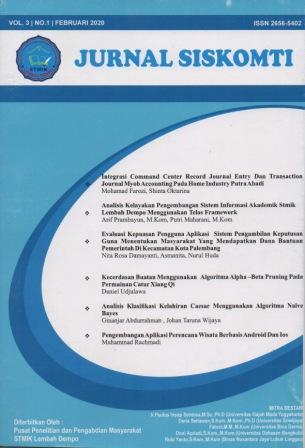ANALISIS KLASIFIKASI KELAHIRAN CAESAR MENGGUNAKAN ALGORITMA NAÏVE BAYES
Keywords:
Birth, Caesar, Classification, Naive Bayes, WekaAbstract
The maternal mortality rate (MMR) in Indonesia is still high. AKI is the number of maternal deaths during pregnancy, childbirth and childbirth caused by pregnancy, childbirth and childbirth or management and is not caused by accident or falls in every 100,000 live births. Caesarean birth is the last alternative in the act of labor. This is because of the high risk factors, both risks for both mother and baby. Despite the high risk, Caesar's birth rate has increased significantly, especially in Indonesia. The World Health Organization (WHO) sets a standard for Caesarean delivery in a country of around 5-15 percent per 1000 births in the world. Machine learning learns how machines or computers learn from experience or how to program machines to learn. Machine learning requires data to learn or in other words termed learn from data. There are several machine learning applications that have been developed. One is WEKA machine learning (Waikato Environment for Knowledge Analysis). Weka is a data mining software that is equipped with a standard machine learning algorithm, including preprocessing, classification, clustering, regression, association, and visualization algorithms. In this study the classification of Caesar's birth will be carried out using the Naïve Bayes algorithm to determine whether the birth will be given an act of Caesarean section or a normal delivery (No Caesar). The dataset used consists of 80 data of pregnant women with 5 attributes, namely: age, number of medical personnel, delivery time, blood pressure, liver problems. The results of this study are expected to help the health world especially to determine the birth process need to be given Caesarean section or not by providing a classification model to make medical predictions. The results of this study are expected to be able to support the world of health, especially in the case of giving birth by providing a classification model that can be used to make predictions and other medical decision making.
References
Anggorowati, & Sudiharjani, N. (2010). Mobilisasi Dini dan Penyembuhan Luka Operasi Pada Ibu Post Sectio Caesarea (SC) di Ruang Dahlia Rumah Sakit Umum Daerah Kota Salatiga. Prosiding Seminar Nasional Dan Internasional Universitas Muhammadiyah Semarang, 30–35.
Kemenkes. (2017). Profil Kesehatan Indonesia Tahun 2016. https://doi.org/10.1111/evo.12990
Lukman, A., & Marwana. (2015). Machine Learning Multi Klasifikasi. Konferensi Nasional Ilmu Komputer (KONIK) 2014, (December 2014).
Sihombing, N., Saptarini, I., & Putri, D. S. K. (2010). Determinan Persalinan Sectio Caesarea Di Indonesia (Analisis Lanjut Data Riskesdas 2013). Jurnal Kesehatan Reproduksi, 8(1), 63–75. https://doi.org/10.22435/kespro.v8i1.6641.63-75


.jpg)




